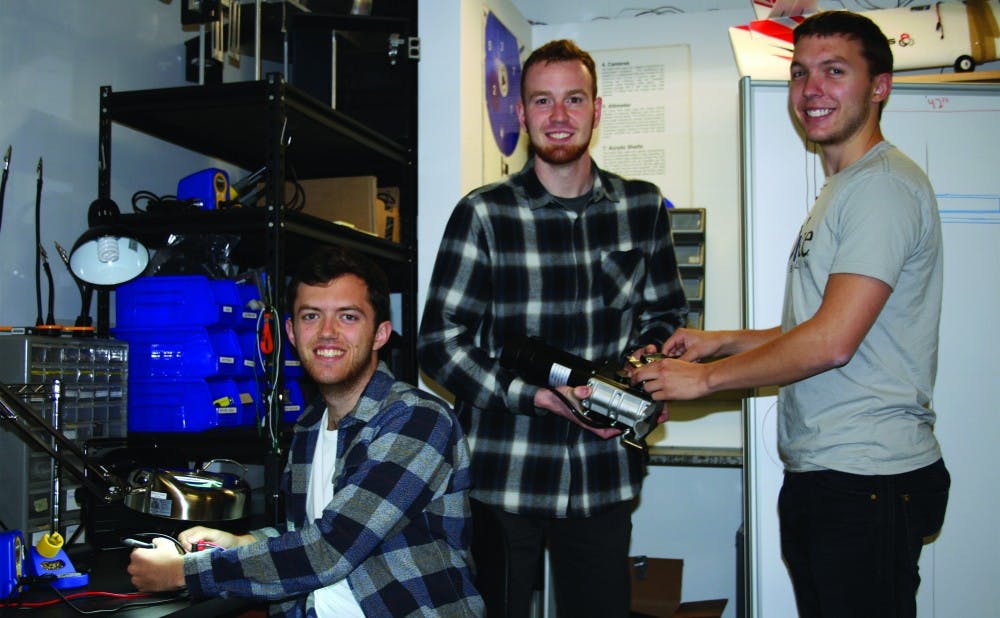Researchers wanting to avoid tick-transmitted diseases may soon have a new tool at their disposal—a tick-collecting robot being developed by Duke undergraduates.
The robot—created by juniors Andrew Buie, Austin McKee and Logan Rooper—was designed to mitigate the many health risks researchers face in working closely with ticks. Dr. Greg Gray, member of the One Health team in the Duke Global Health Institute and professor in the School of Medicine, worked closely with the student-run Duke Robotics club in the Pratt School of Engineering. He emphasized that projects such as the tick-collecting robot embody One Health’s primary initiative—to incorporate interdisciplinary fields of science in a collaborative effort.
“Today we have these difficult problems in public health that cannot be approached by just one discipline, so we need to work across disciplines in teams,” Gray said.
Gray noted that the issue of ticks in research, although highly specific, is of immense concern. The study of ticks and their roles in infectious disease is critical as they carry viruses, bacteria and parasites, Gray explained. Research of ticks is crucial to public health, but as a result, there are many health risks associated with the arachnids.
During the summer, Buie and Rooper, co-presidents of Duke Robotics, did field work with Gray in the Duke Forest to study the process of tick collection, which Rooper described as “very manual.” Buie and Rooper than came up with a proposal for a robot that would emulate what the researchers were doing while preventing exposure to ticks. McKee was later approached by Rooper and Buie to join the team.
“It’s out of character for us to work on a project like this that has so much overlap with medicine and all these fields we never really get to touch on, so it’s a really interesting opportunity,” Rooper said.
The robot itself will resemble a mini-cart with two front wheels and a swivel wheel in the back, utilizing a differential drive system such that movement is based on two separately driven wheels. The robot will feature high-power motors that enable the vehicle to travel in different conditions.
Rooper explained that the vehicle structure was similar to those made in the engineering class, ECE 110. Other parts of the robot include a plastic box that holds the electronics and the “meat of the machine”, the tick-collection device which attempts to mimic the mannerisms of a human being.
“Ticks are attracted to things that move and emit heat and carbon dioxide, so we built a robot that tries to emulate what a person would be like moving through a forest,” Rooper said. “[The robot] has a big piece of cloth that sweeps out the ground behind it. Coincidentally, this is how researchers [collect ticks] today.”
McKee, a vice president of Duke Robotics who is in charge of the tick robot’s frame design, said he was confident in the group’s ability to carry out the project.
“We do have some pretty detailed sketches with the exact frame and the exact dimensions drawn to scale,” McKee said.
One of the major engineering challenges that the team faces is designing a robot that can effectively move about in the forest. Although the trio anticipates that the differential drive system should help the robot maneuver different terrains, they imagine more challenges will arise after testing. Another pending issue is creating a safe method to test the robot. Because of the impracticality and risk of bringing ticks into the lab, the trio is contemplating purchasing ladybugs to function in place of ticks.
Rooper noted that his personal motivation for getting involved in the project was his personal experience with the detrimental effect ticks can have on humans.
“I had a friend in high school who had Lyme disease and I really saw it affect him,” Rooper said. “He went from this really crazy, awesome and entertaining dude to someone who struggled in school and he was sick all the time. If we can have researchers be safer during their study of ticks and parasites, we can come up with solutions faster.”
Get The Chronicle straight to your inbox
Signup for our weekly newsletter. Cancel at any time.

